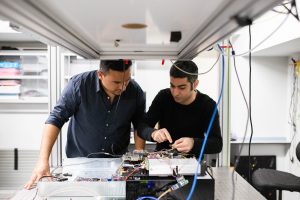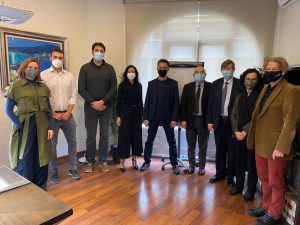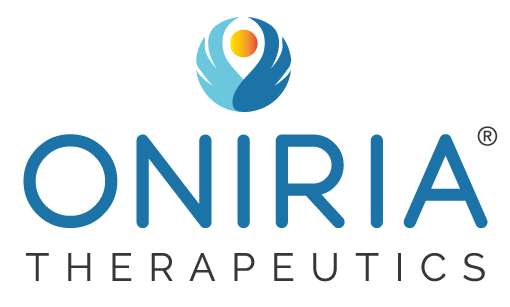Technology Transfer
Technologies protected in 2021
39
| ICREA | |
|---|---|
|
EXPERIMENTAL SCIENCES & MATHEMATICS |
|
| Xavier Barril (UB) |
|
| Julio Lloret (ICIQ) |
|
| Morgan Mitchell (ICFO) |
|
| Víctor Puntes (ICN2-VHIR) |
|
| Xavier Salvatella (IRB Barcelona) |
|
| ENGINEERING SCIENCES | |
| Antonio Acín (ICFO) |
|
| Giuseppe Battaglia (IBEC) |
|
| Jordi Cabot (UOC) |
|
| Turgut Durduran (ICFO) |
|
| Jose Antonio Garrido (ICN2) |
|
| Daniel Maspoch (ICN2) |
|
| Josep Nogués (ICN2) |
|
| Valerio Pruneri (ICFO) |
|
| Jelena Radjenovic (ICRA) |
|
| Albert Tarancón (IREC) |
|
| LIFE & MEDICAL SCIENCES | |
| Joaquín Arribas (PSMAR & VHIO) |
|
| Salvador Aznar Benitah (IRB Barcelona) |
|
| Josep Dalmau (IDIBAPS) |
|
| Manel Esteller (IJC) |
|
| Pau Gorostiza (IBEC) |
|
| Josep M. Llovet (IDIBAPS) |
|
| Javier Martínez Picado (IRSICaixa) |
|
| Pura Muñoz (UPF) |
|
| Antonio Postigo (IDIBAPS) |
|
| Natasa Przulj (BSC-CNS) |
|
| Luis Serrano (CRG) |
|
| Isabelle Vernos (CRG) |
|
Science to Society – ERC Proof of Concept grants
The ERC Proof of Concept Grants aim to maximise the value of the excellent research that the ERC funds, by funding further work (i.e. activities which were not scheduled to be funded by the original ERC frontier research grant) to verify the innovation potential of ideas arising from ERC funded projects. Proof of Concept Grants are therefore on offer only to Principal Investigators whose proposals draw substantially on their ERC funded research.
11
Jens Biegert · miniX - MINIaturitzed coherent soft X-ray source for research and industry
X-rays are a prime analytical tool across a diverse range of areas in our modern economy—from fundamental physics and chemistry research, to the pharmaceutical and semiconductor industries. In particular, sources of ultrafast coherent x-rays are expected to have a transformative impact in all of these areas due to their capacity to enable the study of interactions between charge carriers and atoms in gases, liquids and solids, in real-time, and with element specificity. Ease of use, compactness and price will prove vital for any new X-ray technology looking to find use in industrial applications. “miniX” will address all of these issues with the miniaturization of a laser-based soft x-ray source, designed for lay user operation and at low cost.
Jens Biegert – Institut de Ciències Fotòniques (ICFO)
ERC – PoC2018
Daniel Maspoch · Hybead - Hybrid Bead Adsorbents
Hybead – Hybrid Bead Adsorbents
Each year, millions of people, most of them children, die from diseases associated with inadequate water supply, sanitation and hygiene. In particular, exposure to heavy metals in drinking water, even at trace levels, poses a considerable health risk. As included in one of the seventeen sustainable development goals of the United Nations, “safe water and adequate sanitation are indispensable for healthy ecosystems, reducing poverty, and achieving inclusive growth, social well-being and sustainable livelihoods”. In this PoC project, named Hybrid Bead Adsorbents (Hybead), we aim to evaluate the feasibility of advancing Hybrid Inorganic Nanoparticle/Metal-Organic Frameworks Bead-type adsorbents into the pre-commercial stage, with the aim of accelerating their access to the market as an efficient technology for removing heavy metal ions from water. The first part of Hybead encompasses scaling-up of our current spray-drying synthesis of these beads from the gram-scale to economically viable kilogram-scale production. We will also shape the composite beads for proving its use into existing water purification technologies. This will entail shaping Hybead into granules and integrating them as fillers into polymer matrices to produce membranes by common industrial-scale methods (e.g. compaction and solvent casting). The second part of Hybead will be dedicated to intellectual property (IP) and market aspects needed for the pre-commercialization of this new technology for water purification. This study will include a patentability study, a freedom-to-operate (FTO) analysis and a market study to identify the filter producers that could ultimately serve as manufacturing partners. In this project we will endeavor to assess the commercial viability of with Hybead adsorbents, accelerate their market entry and ultimately, explore the possibility of launching a spin-off to manufacture and commercialize viable products.
Daniel Maspoch – Institut Català de Nanociència i Nanotecnologia (ICN2)
ERC – PoC2019
Paolo Melchiorre · Light-COAT - Visible Light-Activated Photoinitiators for Applications in Domestic Coatings
Light-COAT – Visible Light-Activated Photoinitiators for Applications in Domestic Coatings
The use of light to trigger and control radical polymerisation is a powerful strategy for rational polymer synthesis and advanced materials. Photoinitiated polymerisation is today widely used in industry for several applications. Essential for the continued progress of the field is the discoveries of novel photoinitiators endowed with tailored properties, such as high activity at ambient temperature and the possibility to use visible light instead of UV irradiation to produce radicals in high quantum yields. Using visible light is essential for domestic applications, as there would be no hazards related to exposure to UV light. Light-COAT aims at preparing new visible-light-activated photoinitiators and evaluate their potential for the formulation of domestic coating compositions. As part of the ERC-2015-CoG project CATA-LUX (681840), focused on developing photochemical synthetic methodologies, we recently identified a family of visible-light-absorbing organic compounds with high potential to act as photoinitiators for polymer applications. These photoinitiators can be easily synthesised, are activated by weak light, including solar light or simple light-emitting-diodes, provide access to colourless polymeric materials, and have shown potential for applications in domestic indoor/outdoor coatings. These unique features make this novel family of photoinitiators suitable to enhance convenience in use (reduced drying time and improved weatherproof feature), offering a strong opportunity to improve domestic coating formulations.
Paolo Melchiorre – Institut Català d’Investigació Quimica (ICIQ)
ERC – PoC2019
Pablo Menéndez · IT4B-ALL - Therapeutic immunotherapy targeting NG2 and CD22 antigens for MLL-rearranged and MLL-germline B-cell Acute Lymphoblastic Leukemia
IT4B-ALL – Therapeutic immunotherapy targeting NG2 and CD22 antigens for MLL-rearranged and MLL-germline B-cell Acute Lymphoblastic Leukemia
B-ALL is the commonest cancer of childhood. There remain childhood B-ALL subgroups with dismal prognosis such as infant B-ALL and B-ALL carrying MLL rearrangements (MLLr). In addition, the prognosis of adult B-ALL is worse, and refractory/relapse (R/R) B-ALL remains dismal. CD19-targeted immunotherapies have emerged as promising therapeutic approaches for R/R B-ALL. CD19 CAR T-cells have shown impressive efficacy in R/R B-ALL. However, relatively rapid relapses are frequently observed, a proportion of them losing CD19 expression upon CAR19 T-cell therapy due to massive antigen pressure over CD19, resulting in a myeloid lineage switch in MLLr B-ALL, or the selection of CD19-/CD34+ preleukemic progenitors. Further CD19-targeted therapy is thus ineffectual for CD19neg R/R B-ALL. Our overarching goal is to provide novel therapeutic options for (R/R) B-ALL.Targeting surface antigens whose expression, opposite to CD19, are commonly retained at relapse is a valid strategy to circumvent the loss of CD19 found in (R/R) B-ALL after CD19-targeted therapies. Recent work funded by my ERC-2014-CoG has identified NG2 and CD22 as key antigens to be targeted in (R/R) B-ALL. First, both antigens are retained in CD19neg R/R B-ALL. Second, NG2 is solely expressed in MLLr B-ALL, and is associated with CNS infiltration, aggressiveness and glucocorticoid resistance. Third, CD22 is a pan-B marker expressed developmentally earlier than CD19, and CD34+CD22+CD19- cells may represent pre-malignant progenitors escaping the CD19-targeted pressure. These results have just been protected by a European Patent (EPI173825514), and are the proof-of-principle demonstration of NG2 & CD22 representing promising immunotherapeutic targets, when combined with CD19 for both MLLr & MLL-germline B-ALL, respectively. Here we propose to consolidate preclinical work and GMP production of anti-NG2 monoclonal antibody and NG2/CD19 and CD22/CD19 CAR T-cells to launch a PhaseI academic clinical trial for R/R B-ALL.
Pablo Menéndez – Institut Josep Carreras (IJC)
ERC – PoC2018
Natasa Przulj · GENETTA - Genomic Data-Fusion Platform for Omics-Driven Precision Medicine
Natasa Przulj – Barcelona Supercomputing Centre – Centro Nacional de Supercomputación (BSC – CNC))
ERC – PoC2020
Victoria Reyes García · ICCION - Indigenous Climate Change Impacts Observation Network
Victoria Reyes García – Universitat Autònoma de Barcelona (UAB)
ERC – PoC2019
Neus Sabaté · POWER-PATCH - Self-Powered Skin Patch for Cystic Fibrosis Diagnosis
Neus Sabaté – Institute of Microelectronics of Barcelona – Centre Nacional de Microelectónica (CSIC – IMB-CNM)
ERC – PoC2019
Manuel Serrano · SENFIB - Novel senolytic drugs for the treatment of lung and kidney fibrosis
Manuel Serrano – Institut de Recerca Biomèdica (IRB Barcelona)
ERC – PoC2020
Jordi Sort · MAGIC-SWITCH: Magnetic Switch Controlled with Voltage
Jordi Sort – Universitat Autònoma de Barcelona (UAB)
ERC – PoC2019
Sergio Valenzuela · SOTMEM - Topological Insulator-Based Spin Orbit Torque MEMories
Sergio Valenzuela – Institut Català de Nanociència i Nan0tecnologia (ICN2)
ERC – PoC2019
Paul Verschure · cRGS - Cognitive Rehabilitation Gamming System (cRGS): a novel Virtual Reality-based system for the conjunctive training of stroke-derived cognitive impairments
Paul Verschure – Institut de Bioenginyeria de Catalunya (IBEC)
ERC – PoC2018
Spin-off companies
4
Chatbot Creation Services SL
Supported by the Universitat Oberta de Catalunya and ICREA
Entrepreneur: ICREA Research Professor Jordi Cabot
Born in June 2021
Chatbot Creation Services is a spin-off company of the Universitat Oberta de Catalunya and ICREA. It was born in 2021 to continue the development and commercialization of the open source chatbot development platform Xatkit, started at the SOM Research Lab.
 Xatkit’s unique approach to chatbots and voice assistants is its focus on minimizing the effort to create them. Instead of requiring a manual definition of the bots, Xatkit is able to take whatever information is already available in the company (documents, databases,…), read it, understand it and use it to generate a first working version of the chatbot. Then, via Xatkit’s graphical interface, companies can monitor and fine-tune the bot whenever needed.
Xatkit’s unique approach to chatbots and voice assistants is its focus on minimizing the effort to create them. Instead of requiring a manual definition of the bots, Xatkit is able to take whatever information is already available in the company (documents, databases,…), read it, understand it and use it to generate a first working version of the chatbot. Then, via Xatkit’s graphical interface, companies can monitor and fine-tune the bot whenever needed.
LuxQuanta Technologies SL
Supported by ICFO and ICREA
Entrepreneur: ICREA Research Professor Valerio Pruneri
Born in October 2021
 LuxQuanta was born in May 2021 as a spin-off from ICFO, and after being incubated for over 4 years, with the mission of developing Quantum Key Distribution (QKD) systems. These systems can distribute cryptographic keys between users with the highest level of security as they rely on the unique properties of quantum physics instead of mathematical algorithms.
LuxQuanta was born in May 2021 as a spin-off from ICFO, and after being incubated for over 4 years, with the mission of developing Quantum Key Distribution (QKD) systems. These systems can distribute cryptographic keys between users with the highest level of security as they rely on the unique properties of quantum physics instead of mathematical algorithms.
LuxQuanta uses a novel QKD technology capable of providing high-performance and cost-effective quantum cryptography solutions, easy to integrate into existing optical network infrastructures while capable of delivering a quantum-safe layer of security on top of traditional crytographic techniques.
From its headquartes in Barcelona and with solid Spanish shareholders foundations, LuxQuanta want to deliver ultra-secure data encryption and communications to all European Union’s governmental institutions, financial sectors, data centers and private telecommunication network providers for years to come

Nuage Therapeutics SL
Supported by IRB Barcelona and ICREA
Entrepreneur: ICREA Research Professor Dr. Xavier Salvatella
Born in July 2021
Nuage Therapeutics (Nuage Tx) is a spin-off company from the Institute for Research in Biomedicine (IRB Barcelona) and ICREA, that stemmed from the Laboratory of Molecular Biophysics lead by Dr. Xavier Salvatella. The company was incorporated on 29th July 2021.
The mission of Nuage Tx is to leverage biomolecular condensation and chemical biology to develop selective modulators of disordered proteins involved in challenging indications representing unmet medical needs.
Nuage Tx was founded by Xavier Salvatella, Mateusz Biesaga and Denes Hnisz, a team of scientists with complementary expertise that provide unique perspective on targeting intrinsically disordered proteins. Xavier Salvatella is an ICREA Professor and Leader of the Laboratory of Molecular Biophysics at IRB Barcelona. He is a renowned expert in intrinsically disordered proteins, biomolecular condensation and the structural properties of the transactivation domain of androgen receptor. Mateusz Biesaga is a PhD student and an MSCA fellow at the laboratory of Xavier Salvatella. He holds a degree in biomedical engineering and has expertise in assay development and validation for drug discovery. Denes Hnisz is the Leader of Precision Gene Control group at the Max Planck Institute for Molecular Genetics in Berlin (Germany). He is a prominent expert in transcriptional control, nuclear condensates and genome structure.
The first program of Nuage Tx aims to develop a potent and selective drug targeting the transactivation domain of androgen receptor to deliver a life-changing treatment to patients with castration-resistant prostate cancer. Nuage Tx is developing a proprietary Condensation Screening Assay and a Target Discovery Algorithm that will be used to identify new targets and new drug candidates. Nuage Tx aims to become a platform company with multiple assets in its pipeline.
Nuage Tx has already in-licensed a patent application from the Institute for Research in Biomedicine (IRB Barcelona) related to a proprietary in vitro condensation assay developed at Dr. Xavier Salvatella’s lab. The core intellectual property of Nuage Tx will be based on protecting the drug candidates once they reach a sufficiently advanced development stage. Other patent applications from public institutions or private entities will be in-licensed, if deemed necessary, to strengthen Nuage Tx’s patent portfolio.
Oniria Therapeutics SL
Supported by UB, VHIR and ICREA
Entrepreneur: ICREA Research Professor Xavier Barril
Born in December 2021
Oniria Therapeutics is a biotech company focused on the development of first-in-class drugs in the field of precision oncology. It develops therapies to modulate and eliminate dormant tumor cells as a novel targeted strategy to overcome their persistence.

Our flagship product, ONR-001, is an oral small molecule, first-in-class, that allosterically activates TET2, a master epigenetic enzyme, causing tumor cells to enter a dormant state and even die. ONR-001 is oncology indication agnostic and can be successfully used at all stages of the disease, from naïve primary tumors to recurrent resistant and metastatic cancer, thus “making a world of difference“.





